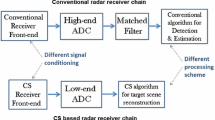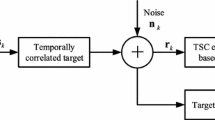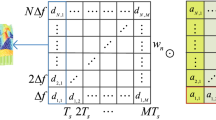Abstract
We introduce the compressive sensing (CS) theory for waveform design of cognitive radar, and then propose an algorithm for the high-resolution radar signal waveform and its corresponding imaging method based on the sparse orthogonal frequency division multiplexing-linear frequency modulation (OFDM-LFM) signal. We first present the principle of spectrum synthesis and high-resolution imaging based on OFDM-LFM signals. Then, we propose the spectrum-sparse waveform design criterion and the reconstruction algorithm for a high-resolution range profile (HRRP) based on CS. Based on this, we analyze in detail the relationship between the scattering characteristics of the target and the parameters of the designed signal, and we construct the feedback of the target characteristics on the waveforms. Therefore, the “cognitive” function of radar can be achieved by adaptively adjusting the waveform with the target characteristics. Simulations are given to validate the effectiveness of the proposed algorithm.
Similar content being viewed by others
References
Haykin S. Cognitive radar: a way of the future. IEEE Signal Proc Mag, 2006, 23: 30–40
Goodman N A. Closed-loop radar with adaptively matched waveforms. In: 2007 International Conference on Electromagnetics in Advanced Applications. Torino: IEEE Press, 2007. 468–471
Goodman N A, Venkata P R, Neifeld M A. Adaptive waveform design and sequential hypothesis testing for target recognition with active sensors. IEEE J Sel Top Signal Proces, 2007, 1: 105–113
Wei Y, Meng H, Wang X. Adaptive single-tone waveform design for target recognition in cognitive radar. In: IET International Radar Conference. Guilin: IEEE Press, 2009. 1–4
Liu F, Wang J. An optimal ADP algorithm for waveform selection in cognitive radar systems. In: PIERS Proceedings. Beijing: Electromagnetics Academy Press, 2009. 728–730
Scala B L, Rezaeian M, Moran B. Optimal adaptive waveform selection for target tracking. In: 8th International Conference on Information Fusion. Philadelphia: IEEE Press, 2005. 25–28
Bell M R. Information theory and radar waveform design. IEEE Trans Inform Theory, 1993, 39: 1578–1579
Donoho D L. Compressed sensing. IEEE Trans Inform Theory, 2006, 52: 1289–1306
Shi G M, Liu G H, Gao D H, et al. Advances in theory and application of compressed sensing (in Chinese). Acta Electron Sin, 2009, 37: 1070–1081
Shi G, Lin J, Chen X, et al. UWB echo signal detection with ultra-low rate sampling based on compressed sensing. IEEE Trans Circuits-II, 2008, 55: 379–383
Baraniuk R, Steeghs P. Compressive radar imaging. In: IEEE Radar Conference. Boston: IEEE Press, 2007. 128–133
Yao Y, Petropulu A P, Poor H V. MIMO radar using compressive sampling. IEEE J Sel Top Signal Proces, 2010, 4: 146–163
Xie X C, Zhang Y H. 2D radar imaging scheme based on compressive sensing technique (in Chinese). J Electron Inform Technol, 2010, 32: 1234–1238
Quan Y H, Zhang L, Guo R, et al. Generating dense and super-resolution ISAR image by combining bandwidth extrapolation and compressive sensing. Sci China Inf Sci, 2011, 54: 2158–2169
Gao T, Zhou F, Li W, et al. A 6.2–9.5 GHz receiver for Wimedia MB-OFDM and China UWB standard. Sci China Inf Sci, 2011, 54: 407–418
Zhang H, Dai X H, Pan D R. Linearly time-varying channel estimation and training power allocation for OFDM/MIMO systems using superimposed training. Sci China Inf Sci, 2011, 54: 1456–1470
Shu F, BERBER S, Wang D M, et al. ML integer frequency offset estimation for OFDM systems with null subcarriers: Estimation range and pilot design. Sci China Inf Sci, 2010, 53: 2567–2575
Chen Y F, Fan J H, Li W, et al. A current-mode RF transmitter for 6–9 GHz MB-OFDM UWB application. Sci China Inf Sci, 2011, 54: 419–428
Prasad N N S S R K, Shameem V, Desai U B, et al. Improvement in target detection performance of pulse coded Doppler radar based on multicarrier modulation with fast Fourier transform (FFT). IEE P-Radar Son Nav, 2004, 151: 11–17
Gu C, Zhang J D, Zhu X H. Signal processing and detecting for multicarrier modulated radar system based on OFDM (in Chinese). J Electron Inform Technol, 2009, 31: 1298–1300
Luo Y, Zhang Q, Qiu C W, et al. Micro-Doppler effect analysis and feature extraction in ISAR imaging with stepped-frequency chirp signals. IEEE Trans Geosci Remote, 2010, 48: 2087–2098
Candès E J, Romberg J, Tao T. Robust uncertainty principles: exact signal reconstruction from highly incomplete Fourier information. IEEE Trans Inform Theory, 2006, 52: 489–509
Candès E J, Tao T. Near-optimal signal recovery from random projections: universal encoding strategies. IEEE Trans Inform Theory, 2006, 52: 5406–5425
Baraniuk R. A lecture on compressive sensing. IEEE Signal Proc Mag, 2007, 24: 118–121
Tropp J A, Gilbert A C. Signal recovery from random measurements via orthogonal matching pursuit. IEEE Trans Inform Theory, 2007, 53: 4655–4666
Kunis S, Rauhut H. Random sampling of sparse trigonometric polynomials II: orthogonal matching pursuit versus basis pursuit. Found Comput Math, 2007, 8: 737–763
Xin M, Bao Z. Properties of range profile of aircraft (in Chinese). Syst Eng Electron, 2002, 24: 65–70
Du L, Liu H W, Bao Z, et al. Radar automatic target recognition based on feature extraction for complex HRRP. Sci China Ser F-Inf Sci, 2008, 51: 1138–1153
Author information
Authors and Affiliations
Corresponding author
Rights and permissions
About this article
Cite this article
Luo, Y., Zhang, Q., Hong, W. et al. Waveform design and high-resolution imaging of cognitive radar based on compressive sensing. Sci. China Inf. Sci. 55, 2590–2603 (2012). https://doi.org/10.1007/s11432-011-4527-x
Received:
Accepted:
Published:
Issue Date:
DOI: https://doi.org/10.1007/s11432-011-4527-x




